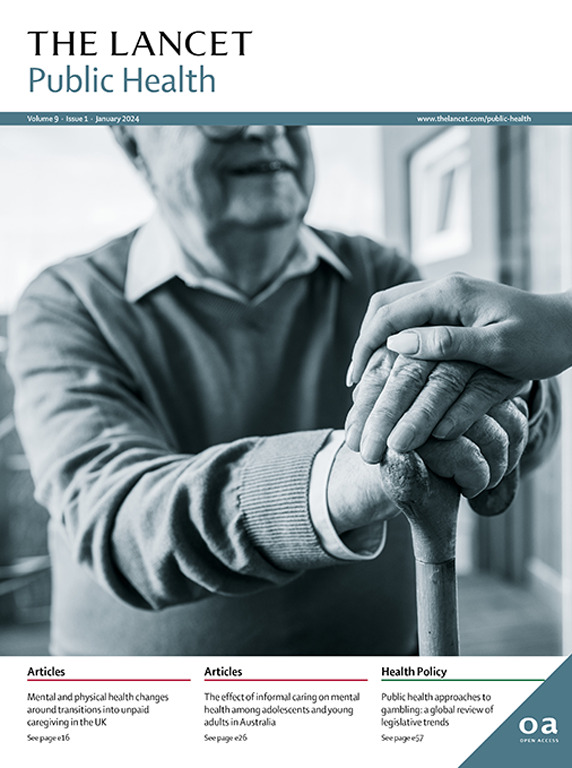Life expectancy by county and educational attainment in the USA, 2000–19: an observational analysis
IF 25.4
1区 医学
Q1 PUBLIC, ENVIRONMENTAL & OCCUPATIONAL HEALTH
引用次数: 0
Abstract
Background
Educational disparities in life expectancy in the USA have been documented nationally but have not been comprehensively explored at the county level. Such geographical granularity is necessary for determining how these disparities vary across the country, thus highlighting the populations that could benefit most from increased access to educational support. We aim to estimate life expectancy at age 25 years for US counties from 2000 to 2019 for four educational attainment populations: less than high school, high-school graduate (including certificate of high school equivalency or other alternative credentials), some college (including associate degrees and incomplete college), and college graduate (including graduate and professional degrees).Methods
In this observational analysis, we estimated age-specific mortality by educational attainment, county, sex, age, and year using validated small-area estimation models, and then used standard life table techniques to estimate life expectancy at age 25 years using deaths data from the US National Vital Statistics System and population data from the 2000 decennial census, American Community Survey, and National Center for Health Statistics between Jan 1, 2000, and Dec 31, 2019. Estimates were adjusted for misclassification of educational attainment on death certificates and format changes to how education is captured on death certificates. We masked (ie, did not display) estimates for counties and educational attainment populations with a mean annual population of less than 1000.Findings
Nationally, in all years there was a clear educational gradient in life expectancy at age 25 years where those with higher levels of education had higher life expectancy: individuals who had completed a college degree had higher life expectancy compared with those who had completed some college education (by 0·3 to 2·0 years over the study period), those who had completed some college had higher life expectancy than the high-school graduate population (by 4·1 to 4·9 years over the study period), and those who had graduated high school had higher life expectancy than those with less than a high-school education (by 3·4 to 5·1 years over the study period). From 2000 to 2019, life expectancy increased by 2·5 years (95% uncertainty interval 2·4 to 2·6) for the college graduate population, 0·7 years (0·6 to 0·8) for the population who had completed some college, and 0·3 years (0·3 to 0·4) for the high-school graduate population; there was no net change for those with less than a high-school education (0·0 years [−0·1 to 0·1]). In every educational attainment population, life expectancy increased by more from 2000 to 2010, with diminishing gains or even declines from 2010 to 2019. Life expectancy varied at the county level; eg, in 2019, the IQR for the population with less than a high-school education was 67·4 to 72·1 years, whereas for the college graduate population it was 82·3 to 84·6 years among counties with unmasked estimates. The college graduate population had higher life expectancy than those who had completed some college in 1937 (81·1%) of 2389 counties (47·1% statistically significant), which in turn had higher life expectancy than the high-school graduate population in 2726 (97·7%) of 2791 counties (87·0% statistically significant), which in turn had higher life expectancy than the population with less than a high-school education in 2356 (95·9%) of 2456 counties (91·6%). Over the study period, the gap in life expectancy between the college graduate population and those with less than a high-school education grew in 2594 (84·8%) of 3060 counties.Interpretation
Educational disparities in life expectancy are large, widespread, and increasing, both nationally and in most counties throughout the USA. Further research is needed to determine how both more equitable access to higher education and efforts to mitigate barriers to good health facing people with lower levels of education might result in better health and longer lives.Funding
Intramural Research Program, National Institute on Minority Health and Health Disparities; National Heart, Lung, and Blood Institute; Intramural Research Program, National Cancer Institute; National Institute on Aging; National Institute of Arthritis and Musculoskeletal and Skin Diseases; Office of Disease Prevention; and Office of Behavioral and Social Sciences Research, US National Institutes of Health.求助全文
约1分钟内获得全文
求助全文
来源期刊

Lancet Public Health
Medicine-Public Health, Environmental and Occupational Health
CiteScore
55.60
自引率
0.80%
发文量
305
审稿时长
8 weeks
期刊介绍:
The Lancet Public Health is committed to tackling the most pressing issues across all aspects of public health. We have a strong commitment to using science to improve health equity and social justice. In line with the values and vision of The Lancet, we take a broad and inclusive approach to public health and are interested in interdisciplinary research.
We publish a range of content types that can advance public health policies and outcomes. These include Articles, Review, Comment, and Correspondence. Learn more about the types of papers we publish.
 求助内容:
求助内容: 应助结果提醒方式:
应助结果提醒方式:


